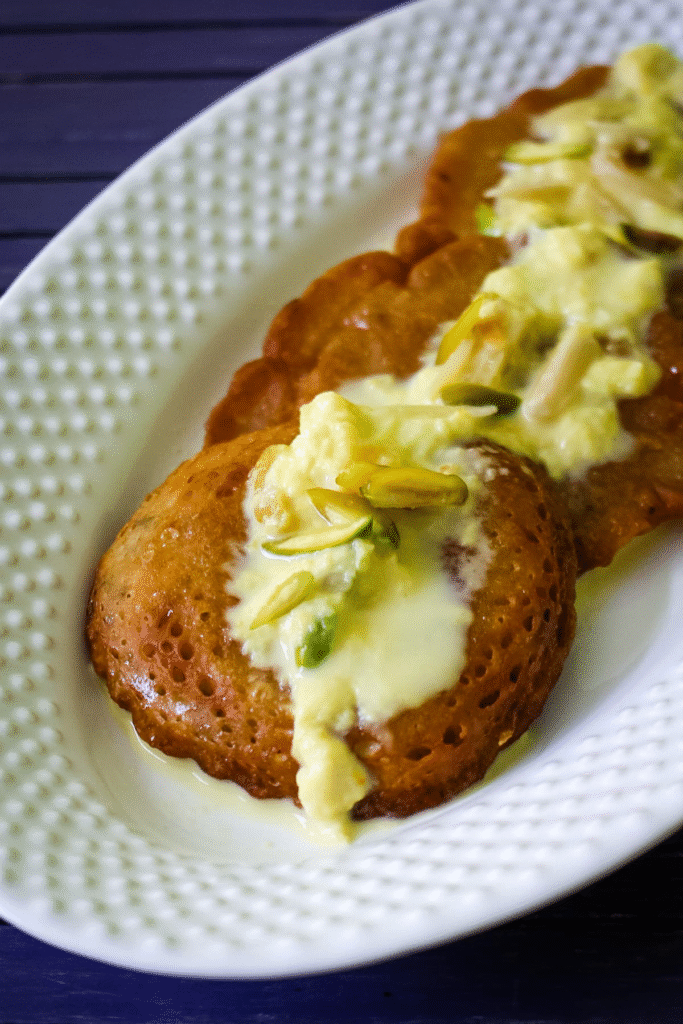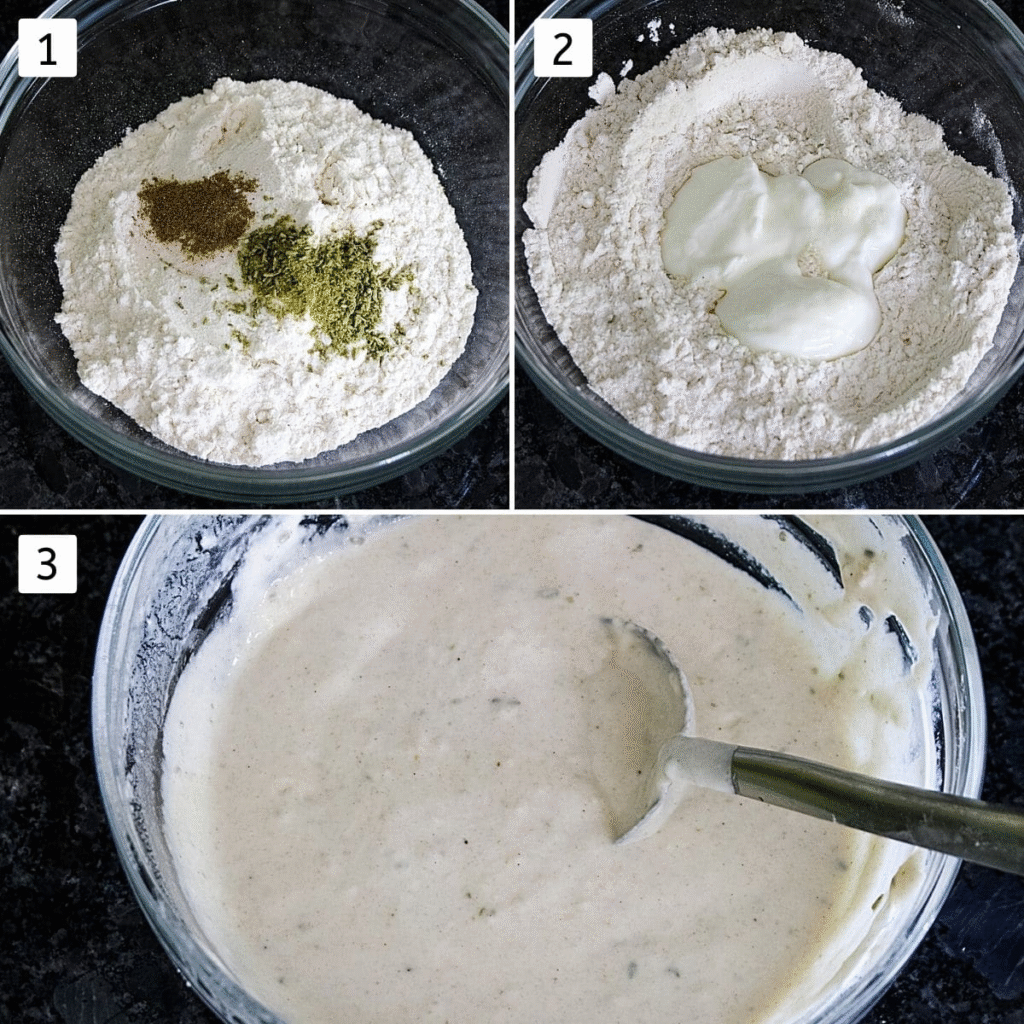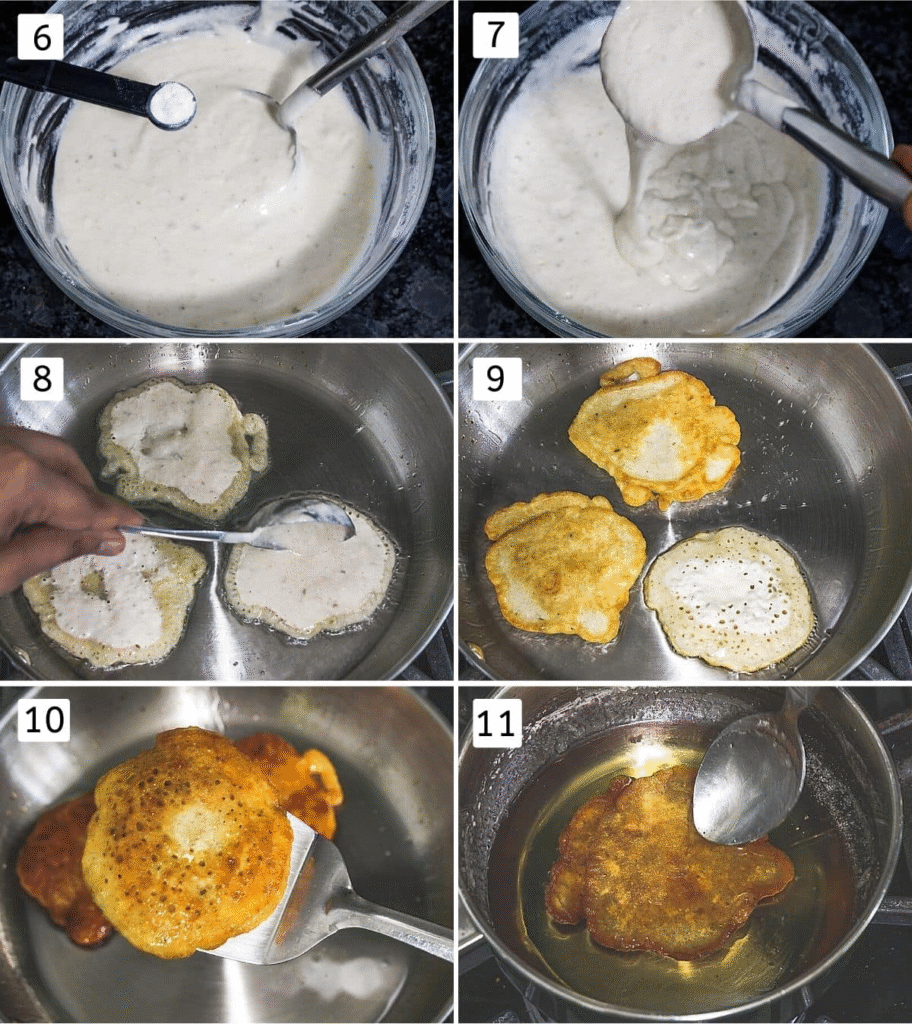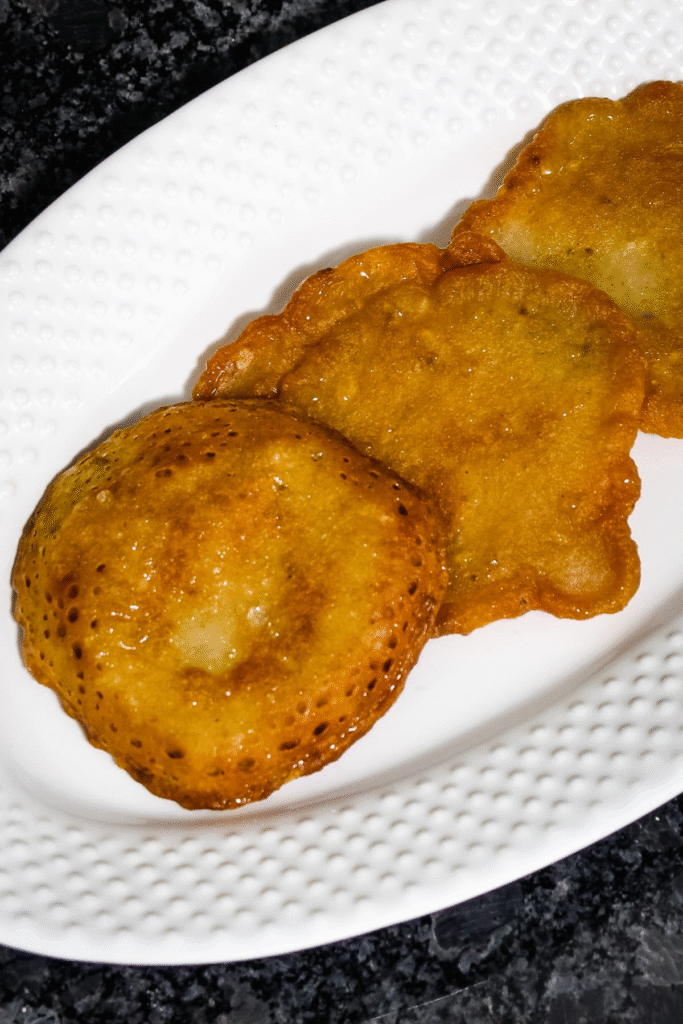In my honest opinion, malpua is truly one of the finest desserts in the world—especially when it’s made fresh at home from scratch. There’s something incredibly comforting about biting into a warm, soft, and slightly crisp malpua that’s been lovingly prepared with care. Over the years, I’ve tried countless versions—both at home and from popular mithai shops—but I can confidently say this homemade malpua recipe is unmatched. It’s richer in flavor, softer in texture, and has that irresistible homemade charm you just can’t find elsewhere.
If you’ve struggled to get malpua just right—whether they turned out too hard, greasy, or unevenly cooked—don’t worry. I’ve poured all my experience into this recipe and included every tip, trick, and little secret I’ve learned along the way to help you nail it perfectly every single time. Keep reading to unlock the foolproof method to making malpua that’s golden, aromatic, and utterly indulgent.

What is Malpua?
Malpua is a rich, indulgent Indian dessert that consists of ghee-fried pancakes made from a smooth, spiced batter of all-purpose flour (maida), then dipped in fragrant sugar syrup until they soak up just the right amount of sweetness. These luscious pancakes often carry a golden, crisp edge with a soft, slightly chewy center, making every bite utterly delightful. Traditionally, they are served warm and are sometimes lavishly topped with creamy, thickened milk known as rabdi, which adds a luxurious touch.
This beloved dessert holds a special place in festive celebrations across many Indian states including Rajasthan, Uttar Pradesh, Bihar, Odisha, and West Bengal. Each region adds its own distinct twist to the recipe—some incorporate mashed ripe bananas, mango pulp, or even pineapple puree into the batter for an added fruity richness. In some Eastern variations, especially in Odisha, malpua is a key offering during Jagannath Rath Yatra and is made with coconut and fennel flavors.
The version I’m sharing here is a fruitless and khoya-free malpua, most commonly found in Rajasthan and Uttar Pradesh. It features a simple yet flavorful batter enhanced with fennel seeds and cardamom, fried to perfection in pure ghee for that authentic festive aroma. Unlike the richer versions loaded with khoya or fruits, this style of malpua keeps the texture lighter and is more reliant on the sugar syrup and optional rabdi topping for depth of flavor.
Malpua is especially cherished during the festival of Holi, when vibrant colors, joyous celebrations, and traditional sweets take center stage. Prepared in advance or fried fresh during the celebration, these sweet pancakes are a nostalgic part of many people’s childhood memories and festive rituals. Whether served on their own or accompanied by a generous drizzle of warm rabdi and a sprinkle of chopped nuts, malpua continues to win hearts with its timeless charm.
❤️ You’ll Love This Malpua Recipe
These malpuas boast crispy golden edges with a soft, airy, and spongy center that melts in your mouth. Unlike the traditional version—where the batter is left to ferment for 8 to 12 hours to develop a rich, fluffy texture—this is an instant malpua recipe that skips the long wait. The batter needs just a 30-minute resting period, yet still delivers impressive results.
The actual cooking takes only about 20 minutes, making it a quick and satisfying sweet treat. Paired with creamy rabri, this dessert is a festive favorite—perfect for celebrations like Diwali, Holi, Navratri, Raksha Bandhan, or any joyous occasion.
🧾 Ingredients
Here’s a picture showcasing all the ingredients you’ll need to make delicious homemade malpua. The best part? Every item is a kitchen staple and most likely already in your pantry—no fancy or hard-to-find ingredients here! So, why wait? Grab your notepad, jot down the recipe, and get started on this delightful Indian dessert today.
This is a quick, instant version of the traditional malpua recipe, made without the usual long fermentation process. To mimic that slight tang and the soft, fluffy texture of the fermented batter, we use yogurt and a touch of baking powder. Together, they do a fantastic job of creating that rich, spongy bite in far less time.
In the image below, you’ll also notice milk infused with saffron threads. These ingredients are not part of the malpua itself but are used in preparing the creamy, luxurious rabdi served on top. I’ve paired this batch of malpua with homemade rabdi to make it even more indulgent and festive. However, if you’re planning to enjoy malpua on its own or keep things lighter, feel free to skip the rabdi—just leave out the milk and saffron, and you’re good to go.

👩🍳 How To Make Malpua? (Stepwise)
1) In a spacious mixing bowl, whisk together all-purpose flour (maida), aromatic cardamom powder, and finely ground fennel seed powder. Let the fragrant spices blend evenly into the flour, creating a delicately spiced base for your batter. These aromatic spices will give your malpua its signature sweet, floral undertones. Use a whisk or spoon to mix everything evenly, ensuring the dry ingredients are well-blended.
2) Add the yogurt to the dry mix. Begin mixing gently to incorporate it into the flour. The yogurt not only enhances the flavor but also mimics the slight tang of a traditionally fermented batter, making this an effective shortcut for the instant version.
3) Gradually pour in water, stirring continuously to form a smooth, lump-free batter. The consistency should be thick enough to coat the back of a spoon but still flow easily when poured. After preparing the batter, cover the bowl with a clean kitchen towel or lid and set it aside for 30 minutes. This brief resting period allows the flour to fully absorb the liquids and gives the spices time to infuse, enhancing the overall flavor and texture of the final dish.

4) While the batter rests, begin preparing the sugar syrup. In a heavy-bottomed saucepan, combine the sugar with an equal amount of water. Set the pan over medium heat and stir slowly, allowing the sugar to melt completely into the water, forming a smooth, clear syrup.
5) Once the syrup comes to a rolling boil, lower the heat and allow it to simmer for a few more minutes. What we’re aiming for is a sticky consistency—thicker than plain syrup, but not as thick as honey. To test, pinch a drop between your fingers; it should form a single thread when pulled apart, known as ½ string consistency. Turn off the heat and set aside.

6) Just before frying, stir baking powder into the rested batter. This step is essential as it activates the leavening right before cooking, resulting in a soft and spongy texture inside while keeping the outer edges crisp.
7) Mix the batter thoroughly once more. By now, it should have a thick yet pourable, flowing consistency—ideal for ladling into hot ghee or oil. If it feels too thick, you can adjust with a splash of water, but don’t over-thin it.
8) In a broad, shallow pan, heat about 3 to 4 tablespoons of ghee over medium flame for shallow frying. As the ghee begins to shimmer with heat, carefully ladle in about 3 tablespoons of the batter, allowing it to spread naturally into a small circle. Let it settle gently in the pan, sizzling softly as it begins to cook.. Slightly spread it out using the back of the ladle—each malpua should be about 3 to 4 inches wide. Depending on your pan size, you can cook 2 to 3 malpuas at once without crowding.
9) Cook them on a low to medium heat setting. You’ll begin to see the edges turning lightly golden and the surface losing its raw, wet look. That’s your cue to flip. If you flip a little too early, no worries—just flip again and allow that side to cook a bit longer. You’re aiming for even, golden-brown color on both sides.
10) When both sides are beautifully golden and crisp around the edges with a soft, spongy center, drain off the extra ghee and take them out of the pan. As the last batch is nearing completion, gently reheat the sugar syrup on another burner over low heat to keep it warm.
11) Immediately dip the hot malpuas into the warm syrup, letting them soak briefly on each side so they absorb just the right amount of sweetness. Lift them out and place on a plate.

12) Serve the syrup-soaked malpuas warm, garnished with a few slivers of nuts for a simple yet delicious finish.
13) Or elevate the experience—spoon over some warm, creamy rabri and top with chopped pistachios and almonds for a richer, festive dessert.

💭 Expert Tips For Malpua Recipe
- Batter Consistency is Key: You’re aiming for a batter that’s thick but still flows easily when poured. If it ends up too watery, just mix in a spoon or two of flour to restore that perfect, pancake-like consistency. A well-balanced batter is key to perfect malpuas.
- Feel free to substitute ghee with oil if necessary, but be aware—it’ll change the flavor game entirely. Ghee imparts a deep, nutty richness and an unmistakable aroma that oil just doesn’t deliver.
- Healthier Cooking Option: If you want to cut back on deep frying, try preparing the malpuas like pancakes or cheelas. Use a non-stick pan and drizzle a little ghee or oil, cooking each side until golden brown.
- Syrup Consistency is Crucial: Make sure your sugar syrup is sticky—reaching about half-thread consistency. If it’s too thick, the malpuas will only get a surface coating instead of soaking up the sweetness. Over-thick syrup can also lead to crystallization.
- Keeping Syrup Warm for Long Batches: Preparing a big batch? To keep the syrup warm without it thickening or crystallizing, use a hot water bath. Place the syrup pan inside a larger vessel filled with hot water (about 3–4 cups). This gentle heat will keep the syrup at the right temperature without altering its consistency, unlike direct heat from the stove.

